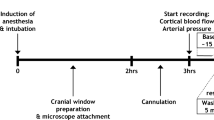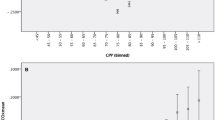Abstract
Cerebrovascular autoregulation (CA) is often impaired following traumatic brain injury. Established technologies and metrics used to assess CA are invasive and conducive for measurement, but not for continuous monitoring. We developed a trans-ocular brain impedance (TOBI) method that may provide non-invasive and continuous indices to assess CA. In this study, we monitored impedance metrics such as respiratory-induced impedance amplitude changes (dz) as well as a novel impedance index (DZx), which is a moving Pearson correlation between mean arterial pressure (MAP) and dz. Yorkshire swine were instrumented to continuously record ICP, MAP, and cerebral blood flow (CBF). TOBI was recorded by placement of standard ECG electrodes on closed eyelids and connected to a data acquisition system. MAP, ICP and CBF were manipulated utilizing an intravenous vasopressor challenge. TOBI indices (dz and DZx) were compared to the hemodynamic indicators as well as pressure reactivity index (PRx). During the vasopressor challenge, dz was highly correlated with ICP, CPP, and CBF (r = < − 0.49, p < 0.0001). ICP, CPP, and CBF had a mean percent increase (standard deviation) from baseline of 29(23.2)%, 70(25)%, and 37(72.6)% respectively while dz decreased by 31(15.6)%. Receiver operator curve test showed high predictive performance of DZx when compared to PRx with area under the curve above 0.86, with high sensitivity and specificity. Impedance indices appear to track changes in PRx and hemodynamics that affect cerebral autoregulation. TOBI may be a suitable less invasive surrogate to PRx and capable of tracking cerebral autoregulation.




Similar content being viewed by others
Data availability
All data and materials support our published claims and comply with field standards.
Code availability
Not applicable.
References
Armstead WM. Cerebral blood flow autoregulation and dysautoregulation. Anesthesiol Clin. 2016;34(3):465–77.
Aaslid R, Lindegaard KF, Sorteberg W, Nornes H. Cerebral autoregulation dynamics in humans. Stroke. 1989;20(1):45–52.
Tzeng YC, Ainslie PN. Blood pressure regulation IX: cerebral autoregulation under blood pressure challenges. Eur J Appl Physiol. 2014;114(3):545–59.
Atkins ER, Brodie FG, Rafelt SE, Panerai RB, Robinson TG. Dynamic cerebral autoregulation is compromised acutely following mild ischaemic stroke but not transient ischaemic attack. Cerebrovasc Dis. 2010;29(3):228–35.
Budohoski KP, Czosnyka M, de Riva N, Smielewski P, Pickard JD, Menon DK, Kirkpatrick PJ, Lavinio A. The relationship between cerebral blood flow autoregulation and cerebrovascular pressure reactivity after traumatic brain injury. Neurosurgery. 2012;71(3):652–60.
Dawson SL, Panerai RB, Potter JF. Serial changes in static and dynamic cerebral autoregulation after acute ischaemic stroke. Cerebrovasc Dis. 2003;16(1):69–75.
Czosnyka M, Smielewski P, Kirkpatrick P, Laing RJ, Menon D, Pickard JD. Continuous assessment of the cerebral vasomotor reactivity in head injury. Neurosurgery. 1997;41(1):11–7.
Jaeger M, Schuhmann MU, Soehle M, Nagel C, Meixensberger J. Continuous monitoring of cerebrovascular autoregulation after subarachnoid hemorrhage by brain tissue oxygen pressure reactivity and its relation to delayed cerebral infarction. Stroke. 2007;38(3):981–6.
Reinhard M, Rutsch S, Lambeck J, Wihler C, Czosnyka M, Weiller C, Hetzel A. Dynamic cerebral autoregulation associates with infarct size and outcome after ischemic stroke. Acta Neurol Scand. 2012;125(3):156–62.
Czosnyka M, Brady K, Reinhard M, Smielewski P, Steiner LA. Monitoring of cerebrovascular autoregulation: facts, myths, and missing links. Neurocrit Care. 2009;10(3):373–86.
Tackla R, Hinzman JM, Foreman B, Magner M, Andaluz N, Hartings JA. Assessment of cerebrovascular autoregulation using regional cerebral blood flow in surgically managed brain trauma patients. Neurocrit Care. 2015;23(3):339–46.
Carney N, Totten AM, O'Reilly C, Ullman JS, Hawryluk GW, Bell MJ, Bratton SL, Chesnut R, Harris OA, Kissoon N, et al. Guidelines for the management of severe traumatic brain injury, fourth edition. Neurosurgery. 2017;80(1):6–15.
Cardim D, Robba C, Bohdanowicz M, Donnelly J, Cabella B, Liu X, Cabeleira M, Smielewski P, Schmidt B, Czosnyka M. Non-invasive monitoring of intracranial pressure using transcranial Doppler ultrasonography: is it possible? Neurocrit Care. 2016;25(3):473–91.
Vranken NPA, Weerwind PW, Sutedja NA, Severdija EE, Barenbrug PJC, Maessen JG. Cerebral oximetry and autoregulation during cardiopulmonary bypass: a review. J Extra Corpor Technol. 2017;49(3):182–91.
Steppan J, Hogue CW Jr. Cerebral and tissue oximetry. Best Pract Res Clin Anaesthesiol. 2014;28(4):429–39.
Zweifel C, Lavinio A, Steiner LA, Radolovich D, Smielewski P, Timofeev I, Hiler M, Balestreri M, Kirkpatrick PJ, Pickard JD, et al. Continuous monitoring of cerebrovascular pressure reactivity in patients with head injury. Neurosurg Focus. 2008;25(4):E2.
Ang BT, Wong J, Lee KK, Wang E, Ng I. Temporal changes in cerebral tissue oxygenation with cerebrovascular pressure reactivity in severe traumatic brain injury. J Neurol Neurosurg Psychiatry. 2007;78(3):298–302.
Depreitere B, Guiza F, Van den Berghe G, Schuhmann MU, Maier G, Piper I, Meyfroidt G. Pressure autoregulation monitoring and cerebral perfusion pressure target recommendation in patients with severe traumatic brain injury based on minute-by-minute monitoring data. J Neurosurg. 2014;120(6):1451–7.
Lazaridis C, Smielewski P, Steiner LA, Brady KM, Hutchinson P, Pickard JD, Czosnyka M. Optimal cerebral perfusion pressure: are we ready for it? Neurol Res. 2013;35(2):138–48.
Tseng MY, Czosnyka M, Richards H, Pickard JD, Kirkpatrick PJ. Effects of acute treatment with pravastatin on cerebral vasospasm, autoregulation, and delayed ischemic deficits after aneurysmal subarachnoid hemorrhage: a phase II randomized placebo-controlled trial. Stroke. 2005;36(8):1627–32.
Tiba MH, McCracken BM, Ansari S, Belle A, Cummings BC, Rajajee V, Patil PG, Alam HB, Ward KR. Novel noninvasive method of cerebrovascular blood volume assessment using brain bioimpedance. J Neurotrauma. 2017;34(22):3089–96.
DeLong ER, DeLong DM, Clarke-Pearson DL. Comparing the areas under two or more correlated receiver operating characteristic curves: a nonparametric approach. Biometrics. 1988;44(3):837–45.
Myburgh JA, Upton RN, Grant C, Martinez A. The cerebrovascular effects of adrenaline, noradrenaline and dopamine infusions under propofol and isoflurane anaesthesia in sheep. Anaesth Intensive Care. 2002;30(6):725–33.
Schwarz S, Georgiadis D, Aschoff A, Schwab S. Effects of induced hypertension on intracranial pressure and flow velocities of the middle cerebral arteries in patients with large hemispheric stroke. Stroke. 2002;33(4):998–1004.
Ma X, Aravind A, Pfister BJ, Chandra N, Haorah J. Animal models of traumatic brain injury and assessment of injury severity. Mol Neurobiol. 2019;56(8):5332–455.
Vella MA, Crandall ML, Patel MB. Acute management of traumatic brain injury. Surg Clin North Am. 2017;97(5):1015–30.
Rivera-Lara L, Zorrilla-Vaca A, Geocadin R, Ziai W, Healy R, Thompson R, Smielewski P, Czosnyka M, Hogue CW. Predictors of outcome with cerebral autoregulation monitoring: a systematic review and meta-analysis. Crit Care Med. 2017;45(4):695–704.
Tavakoli S, Peitz G, Ares W, Hafeez S, Grandhi R. Complications of invasive intracranial pressure monitoring devices in neurocritical care. Neurosurg Focus. 2017;43(5):E6.
Bernstein DP. Impedance cardiography: pulsatile blood flow and the biophysical and electrodynamic basis for the stroke volume equations. J Electr Bioimp. 2010;1:2–17.
Babu JP, Jindal GD, Bhuta AC, Parulkar GB. Impedance plethysmography: basic principles. J Postgrad Med. 1990;36(2):57–63.
Bhuta AC, Babu JP, Jindal GD, Parulkar GB. Technical aspects of impedance plethysmography. J Postgrad Med. 1990;36(2):64–70.
Prabhakar H, Sandhu K, Bhagat H, Durga P, Chawla R. Current concepts of optimal cerebral perfusion pressure in traumatic brain injury. J Anaesthesiol Clin Pharmacol. 2014;30(3):318–27.
Czosnyka M, Czosnyka Z, Smielewski P. Pressure reactivity index: journey through the past 20 years. Acta Neurochir (Wien). 2017;159(11):2063–5.
Donnelly J, Czosnyka M, Adams H, Robba C, Steiner LA, Cardim D, Cabella B, Liu X, Ercole A, Hutchinson PJ, et al. Individualizing thresholds of cerebral perfusion pressure using estimated limits of autoregulation. Crit Care Med. 2017;45(9):1464–71.
Needham E, McFadyen C, Newcombe V, Synnot AJ, Czosnyka M, Menon D. Cerebral perfusion pressure targets individualized to pressure-reactivity index in moderate to severe traumatic brain injury: a systematic review. J Neurotrauma. 2017;34(5):963–70.
Acknowledgements
The authors would like to thank the Michigan Center for Integrative Research in Critical Care for their technical support.
Funding
This study was supported by a grant from the Department of Defense (#W81XWH-18-1-0005).
Author information
Authors and Affiliations
Contributions
All authors contributed to the study conception and design. Material preparation, data collection and analysis were performed by Mohamad Tiba, Brendan McCracken, Danielle Leander, Carmen Colmenero, Brandon Cummings, and Nicholas Greer. The first draft of the manuscript was written by Mohamad Tiba, Brendan McCracken and Kevin Ward. All authors commented on previous versions of the manuscript. All authors read and approved the final manuscript.
Corresponding author
Ethics declarations
Conflict of interest
Dr. Tiba and Dr. Ward have intellectual property on the technology and methodology described through the University of Michigan. The technology has been licensed by New Vital Signs, Inc. in which Dr. Ward is a founder.
Consent to participate
Not applicable.
Consent for publication
Not applicable.
Ethical approval
All procedures outlined in this study adhere to the principles stated in the eighth edition of the Guide for the Care and Use of Laboratory Animals and were approved by the University of Michigan’s Institutional Animal Care and Use Committee.
Additional information
Publisher's Note
Springer Nature remains neutral with regard to jurisdictional claims in published maps and institutional affiliations.
Rights and permissions
About this article
Cite this article
Tiba, M.H., McCracken, B.M., Leander, D.C. et al. Trans-ocular brain impedance index for assessment of cerebral autoregulation in a porcine model of cerebral hemodynamic perturbation. J Clin Monit Comput 35, 1007–1014 (2021). https://doi.org/10.1007/s10877-020-00556-1
Received:
Accepted:
Published:
Issue Date:
DOI: https://doi.org/10.1007/s10877-020-00556-1




